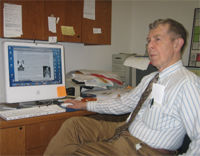Robert Taylor’s (1980a) book, The Computer in the School: Tutor, Tool, Tutee, was a seminal work, bringing together essays written by a number of early pioneers in the field of educational computing.
For the foreseeable future, computing will play an increasingly important role in human learning. However, no one yet knows exactly how great that role will eventually be, or precisely what form it will finally take. (Taylor, 1980b)
Taylor ’s introduction is still required reading in the instructional technology program at the University of Virginia, as well as in other educational technology programs around the world.
Gerald Knezek, president of the Society for Information Technology and Teacher Education (SITE), commented,
Robert Taylor is a pillar, a founder, one of the giants in the field. His original Tutor Tool Tutee book is one that I quoted so much my students took up a collection and bought me a copy … so I didn’t have to keep borrowing from our library! (Personal communication, May 2009)
 Figure 1. Robert P. Taylor, Teachers College (2009)
Figure 1. Robert P. Taylor, Teachers College (2009)
Ann Thompson, editor of the Journal of Computers in Teacher Education (JCTE), credits this book with changing the direction of her career.
We republished Robert Taylor’s (1980b) original introduction to Tutor, Tool, Tutee in the CITE Journal because it is a seminal work that has influenced an entire generation of educational leaders. On the eve of Taylor ’s retirement from Columbia University Teacher’s College, it is worth reflecting on the influence that the book has had and its implications for the future.
The Computer in the School: Tutor, Tool, Tutee
Taylor ’s framework is as useful today as when it was first published:
The framework suggested for understanding the application of computing in education depends upon seeing all computer use in such application as in one of three modes. In the first, the computer functions as a tutor. In the second, the computer functions as a tool. In the third, the computer functions as a tutee or student. (Taylor, 1980b)
The third use – computer as tutee – requires some context. At the dawn of the age of educational computing, prior to the advent of microcomputers, Seymour Papert conceived that children could learn by directing a robot – a floor turtle (Figure 2).
 Figure 2. A floor turtle. (Photo courtesy of Terrapin Software, www.terrapinlogo.com
Figure 2. A floor turtle. (Photo courtesy of Terrapin Software, www.terrapinlogo.com
A pen in the belly of the turtle – which derived its name from its hemispherical shell – could be used to plot figures. For example, the sequence of commands REPEAT 4 [FORWARD 50 RIGHT] caused the turtle to draw a square (Figure 3).
 Figure 3. Teaching the turtle to draw a square
Figure 3. Teaching the turtle to draw a square
A sequence of commands could be named, adding a new word to the turtle’s vocabulary. Papert believed that by teaching the turtle to draw, children could learn embedded mathematical concepts, such as right angles and repeating patterns. The computer, in effect, became a tutee, taught by the child.
A Digital World in the Global School:
Access, Collaborate, Communicate, Experience
During the transition from the 20th to the 21st century, media underwent a transformation from analog to digital formats. The expanded range of possibilities led to a shift in focus, going beyond the original three possibilities identified by Taylor. In an update to his earlier work, Taylor (2003) reflected on the implications of the digital transition. He suggested four verbs categorizing uses of technology in today’s schools, perhaps optimistically, envisioning ways both students and teachers could participate in the learning process: access, collaborate, communicate, and experience.
Perhaps more than Taylor envisioned, digital media have become an integral part of youth culture and the way in which young people now communicate with one another—although not so much a part of school culture. Each day more than ten thousand hours of digital video are uploaded to YouTube alone. The majority of this content is original material, much of it created by youth.
Students are increasingly becoming sophisticated creators as well as consumers of digital media, using media to communicate with one another. The dynamic quality of digital media goes beyond the ability to revise and remix. Mary Madden (2007), a senior research specialist at the Pew Internet and American Life project, reported, “Younger users are the most eager and active contributors to the online video sphere; they are more likely to watch, upload, rate, comment upon and share the video they find.”
YouTube also includes “Share Options” for linking and embedding on other sites such as MySpace, Facebook, Digg, del.icio.us, Stumble Upon, and Mixx. The fluid nature of digital media allows them to be easily shared for collaborative work in which media created by one user is employed as the basis for subsequent works created by others.
Taylor also suggested that students and teachers would directly access and experience an extensive body of information around the world. Students are accessing information from around the world. The Pew Internet and American Life project found that teens regularly use technology to complete school projects – but also reports that this use often takes place outside school, without guidance or instructions by the teacher.
Digital youth often experience this access in real time, as 140 character Twitter messages, a photostream continually updated on Flickr or Facebook, or streaming video transmitted via services such as Ustream. Youth who have grown up embedded in a digital culture cannot imagine experiencing the world in any other way.
Fabricate
In the context of a global economy, one other word – fabricate – might be added to Taylor ’s framework as we look to the future.
Increasingly, not only can analog media be converted to digital formats (A/D conversion), but the process can be reversed and digital media translated into analog formats. Media can move between tangible physical formats to virtual realizations and back again.
 Figure 4. Plotting a figure with a floor turtle (reprinted with permission from Taylor, 1980)
Figure 4. Plotting a figure with a floor turtle (reprinted with permission from Taylor, 1980)
In Papert’s day, a digital to analog converter (DAC) translated children’s digital commands into movement of a Logo turtle across the floor. The turtle’s pen converted its movement into an analog drawing (Figure 4). The transition from atoms (analog media) to bits (digital media) is the first half of a digital revolution. The second half involves the round trip back from bits to atoms, to enable creation of tangible materials based on digital designs.
Personal digital fabrication may lie at the heart of the next technological revolution. Neil Gershenfeld popularized this concept through Fabrication Laboratories at M.I.T. A Fabrication Lab is a community-based center where individuals can design and make (almost) anything. The transition to personal fabrication during the next quarter century may be as significant as the transition to personal computing during the previous quarter century.
Computer-controlled fabrication systems that are the microcomputer equivalent of MIT’s Fabrication Laboratories are now emerging. A personal computer-controlled die cutting machine that shapes paper, cardboard, and vinyl can be purchased for the same price as an ink-jet printer—that is, for less than $500. The advent of personal fabrication systems makes it possible for schools to begin exploring educational implications of the digital fabrication revolution today.
Personal fabrication systems are inexpensive cousins of MIT’s fabrication laboratories and can be used in similar ways to encourage scientific thinking and development of authentic engineering skills. Paper engineering engages students at many levels. It involves abstract concepts and visualization, but also involves problem-solving in the physical world. Computer-controlled die cutters expand and extend these kinds of projects. Students can create tools in response to tangible challenges (for example, see Figure 5).
 Figure 5. Fabrication of a three-dimensional model derived from a two-dimensional drawing illustrating conversion of linear motion to rotary motion.
Figure 5. Fabrication of a three-dimensional model derived from a two-dimensional drawing illustrating conversion of linear motion to rotary motion.
Although it is a precision instrument, a computer-controlled die cutting system is essentially a plotter with a cutting tip in place of a pen. The same vector commands and underlying graphics language and logic that drove the robot turtle in Papert’s lab at M.I.T. are used to control today’s emerging digital fabrication systems.
Papert suggested that use of a tool can also affect the person using the tool, who unknowingly becomes a tutee. The act of digital design and fabrication draws upon many other skills, such as three-dimensional visualization. In effect, digital fabrication returns full circle to the concept of the computer as a tutee, teaching the student through learning embedded in the task.
Global Collaboration and Fabrication
Tony Wagner (2008), director of the Change Leadership Group at Harvard and a senior advisor to the Bill and Melinda Gates Foundation, recently summarized implications of a global economy for K-12 schools in his book, The Global Achievement Gap:
In today’s highly competitive global “knowledge economy,” all students need new skills for college, careers, and citizenship. The failure to give all students these new skills leaves today’s youth — and our country — at an alarming competitive disadvantage. Schools haven’t changed; the world has. (p. xxi)
The skills that he recommends for a competitive global economy are similar to those identified in Robert Taylor’s (2003) “Reflections on the Computer in the School”: collaboration across networks, communication, and problem solving skills in a team context.
In a digital age, a team in one geographic location can create a digital design that is fabricated by a second team in another country. In fact, many of today’s designs are engineered in just this manner. Tony Wagner noted,
Throughout much of the twentieth century the basic skills of reading, computation, and rudimentary writing were the focus of our attention in schools and at home. However, in the twenty-first century, mastery of the basic skills of reading, writing, and math is no longer enough. (p. xxii)
Projects such as the Global Challenge, supported by the National Science Foundation, bring students together in teams from different countries in a similar manner. The majority of projects such as this are currently taking place outside the mainstream of schools and the standard curriculum. A growing number of educators such as Tony Wagner believe that these types of learning opportunities are no longer just a good idea, they are essential in a competitive global future.
This brings us full circle to the wellsprings of educational computing. Pioneers such as those gathered by Robert Taylor for The Computer in the School thought that technology might facilitate learning by allowing students to control the computer. In an ironic twist, the business of the world has shifted to use of computers for communication, collaboration, and fabrication while schools have changed relatively little.
We are now entering a generation in which introduction of these practices into schools is not futuristic; it is simply catching up to the rest of the world. Providing future teachers with a broad perspective on implications of technology and an associated framework for thinking about it increases the chances of realizing its potential benefits in schools and society.
References
Madden, M. (2007, July 25). Online video proliferates as viewers share what they find online [Press release]. Retrieved from the Pew Internet & American Life Project Web site: http://www.pewinternet.org/Press-Releases/2007/Online-video-proliferates-as-viewers-share-what-they-find-online-57-of-online-adults-watc.aspx
Taylor, R. P. (Ed.). (1980a). The computer in school: Tutor, tool, tutee. New York : Teachers College Press.
Taylor, R. P. (1980b). Introduction. In Taylor, R. P. (Ed.), The computer in school: Tutor, tool, tutee. New York : Teachers College Press. Reprinted in 2003 in Contemporary Issues in Technology and Teacher Education [Online serial], 3(1). Retrieved from https://citejournal.org/vol3/iss2/seminal/article1.cfm
Taylor, R. P. (2003). Reflections on The Computer in the School. Contemporary Issues in Technology and Teacher Education [Online serial], 3(1). Retrieved from https://citejournal.org/vol3/iss1/seminal/article2.cfm
Wagner, T. (2008). The global achievement gap. New York : Basic Books.
![]()